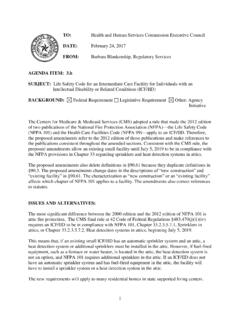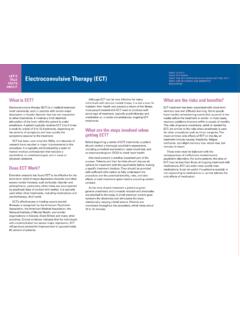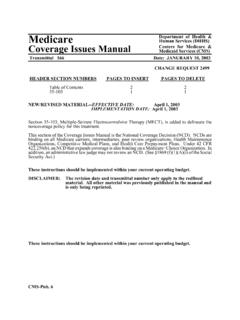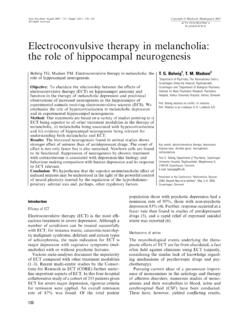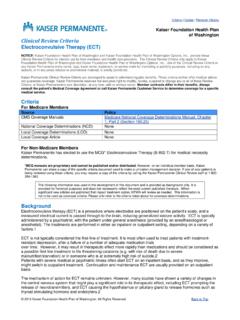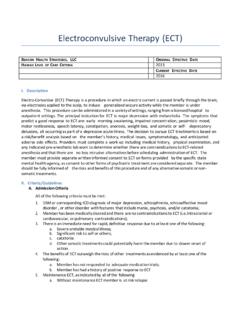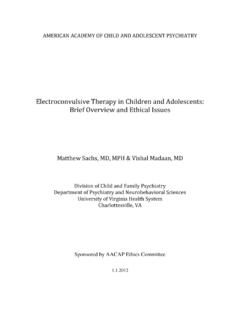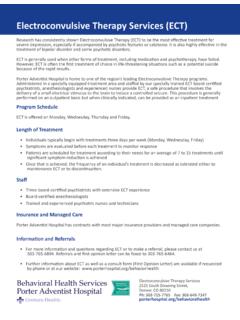Transcription of Electroconvulsive Therapy Report - hhs.texas.gov
1 Report on Electroconvulsive Therapy Fo r Fiscal Year 2017 As Required by Health and Safety Code Section (b) Health and Human Services April 2018 ii Table of Contents Table of Contents .. ii 1. Introduction .. 1 2. Demographic and Treatment Data .. 3 3. Patient Outcomes Data .. 6 Appendix A. Facilities with Registered ECT Equipment .. A-1 1 1. Introduction The Report on Electroconvulsive Therapy for Fiscal Year 2017 is required by Health and Safety Code, Section (b), which states the Health and Human Services Commission (HHSC) must submit a Report on Electroconvulsive Therapy (ECT) annually, by April 1, to the Governor and presiding officer of each house of the Legislature.
2 The Report must include a summary, by facility, of data received from ECT treatment providers under Health and Safety Code, Sections and Other required data include: Number of people who received ECT Number of people voluntarily receiving mental health services who consented to ECT Number of involuntary patients who consented to ECT Number of involuntary patients for whom a guardian consented to ECT Age, sex, and race of the people who received ECT Source of payment for ECT Therapy Average number of non-ECT treatments Average number of ECT treatments administered for each complete series of treatments.
3 But not including maintenance treatments Average number of maintenance ECT treatments administered per month Number of fractures, reported memory losses, incidents of apnea, and cardiac arrests without death Autopsy findings if death followed within 14 days after the date of the administration of ECT All data are from quarterly reports provided by the 21 facilities with registered ECT equipment which performed ECT treatments in fiscal year 2017. Data are annual aggregate total numbers of patients who received ECT across the four quarters.
4 Because patients may receive treatments in multiple quarters, the annual aggregate totals do not reflect the unique number of patients. 1 Some of these data are omitted from this Report due to the small number of individuals reported on. HHS is required by law to safeguard an individual s protected health information from disclosure without the consent of the individual. Omitted information may be available upon request for legally authorized purposes to legally authorized persons who sign a confidentiality agreement.
5 2 ECT is the medical application of an electrical current to cause a therapeutic seizure and decrease the severity of mood-related mental health ECT is a treatment option for some people with severe major depression, bipolar disorder, schizophrenia, catatonia,3 and other mental health conditions. ECT is typically prescribed only after other treatments have not worked. Acute treatment generally includes an initial series of 6 15 treatments, followed by less frequent maintenance treatments. The most common side effects of ECT are short-term and include headaches, muscle pain, nausea, and confusion or memory loss for a few minutes or hours after treatment.
6 More serious, adverse side effects ( , long-term loss of past memories) are less common and may last longer. ECT can only be provided by a physician licensed to practice medicine, cannot be used in children under 16 years old, must only be administered with the proper consent,4 and must be administered using equipment registered with Facilities administering ECT must submit data to HHSC for this Report and to assist with audits, analysis, and monitoring. In fiscal year 2017, 22 facilities registered ECT equipment and were eligible to perform ECT treatments (Appendix A), and 21 facilities performed ECT treatments.
7 Notable findings in fiscal year 2017 include: ECT providers submitted 2,773 ECT reports, and over 17,000 treatments were administered to patients across all four quarters of fiscal year 2017. Patients may receive multiple treatments and may receive treatments in more than one quarter. There was percent increase in the number of ECT treatments from fiscal year 2016 to fiscal year 2017. Overall, patients experienced less severe symptoms after ECT treatments. There was a slight decrease in the number of patients using public funds for treatment payment.
8 There were 2 deaths reported within 14 days of ECT, with both attributed to causes other than ECT. 2 In addition to ECT, Section discusses other convulsive or coma-producing therapies, such as psychosurgery and pre-frontal sonic sound treatment. Definitions for ECT therapies and reportable therapies can be found in Texas Administrative Code, Section 3 A state of apparent unresponsiveness to external stimuli in a person who is apparently awake. 4 Treatments can be stopped at any time by the provider or the person who provided consent (patient or legal guardian).
9 5 As outlined in Health and Safety Code, Chapter 578 and established in department rule. 3 2. Demographic and Treatment Data Figures 1 3 provide patient demographic data on gender, race/ethnicity, and age. Figure 1. Gender/Sex of Patients Figure 2. Race/Ethnicity of Patients 1,79497902004006008001,0001,2001,4001,60 01,8002,000 FemaleMaleGender/Sex2,156354179582605001 ,0001,5002,0002,500 Race/Ethnicity4 Figure 3. Age of Patients Table 1 shows the total number and average number of ECT treatments patients received. Where average totals are provided, the average total across all quarters was computed using non-rounded data from the ECT providers.
10 Table 1. Total Number and Average Number of Treatments Treatment Type Total Average Per Month6 Average Per Patient Maintenance Treatments Administered 5,809 Acute Treatments Planned 18,391 N/A Acute Treatments Administered 11,822 N/A Complete Acute Treatments Administered (series) 6,256 N/A 6 Average monthly treatment data is only required for maintenance treatments. 17168976109551702004006008001,0001,20016 -1718-2425-4445-6465+Age5 Treatment Type Total Average Per Month6 Average Per Patient Non-ECT Treatments7 0 N/A 0 Total Number of ECT Treatments Administered 17,631 N/A Table 2 shows the number of patients that received ECT based on type of consent and admission.




